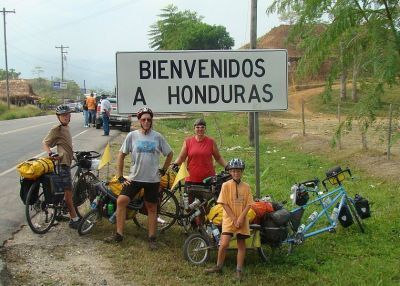Rolf Potts's Blog, page 81
September 13, 2012
Do you pick up accents while traveling?
Vagablogging :: Rolf Potts Vagabonding Blog
My mother tongue is American English. According to my Swedish friend, I speak her native language with a Russian accent. In my own country I’ve been asked where in Australia I’m from. And when I met a guy on the road–who grew up less than an hour from me–I marveled at his strong accent. Why don’t I have the same one?
Language mimicking is common, and often times unintentional. Apparently several years ago Oprah offended someone by doing so. But Arika Okrent, author of “In the Land of Invented Languages” says it’s a human trait to mirror accents, body posture or behavior. And I guess if you listen carefully, Oprah does it all the time. And so do I!
After a few weeks abroad, I began adopting local phrases and arranging words differently. My accent and the pitch at which I spoke morphed. Of course I wasn’t aware of the drastic change until I went home several months later and heard how loud American’s speak. It was almost deafening. One friend told me to “Drop the fake accent.” But it took several months before it began morphing into the local rhythm.
The friend who told me that does not leave town much. When I explain that accents vary within every country—even our own–they only drew a blank stare. Obviously the concept was foreign to them! Yet Curtis at Overseas Exile says living abroad won’t give you an accent. So then why do lots of people pick them up even within their own native country and language?
According to one site, people that pick up accents are language geniuses but don’t realize it! One major trait is being able to identify regional or foreign accents. A second plus is being a musician because, “Language and music both have rhythm, meter, and intonation. Languages and music both have pitch, tempo, and sometimes even melody.”
Relating language to music made complete sense to me. Though I wouldn’t call myself a musician, I’ve played a number of instruments in my life and tend to gravitate to music. I also pick up accents and regional phrases within my own native language.
What do you think? Do you pick up accents while traveling?
Original article can be found here: Do you pick up accents while traveling?
September 10, 2012
Considerations for the Long Term Traveler
Vagablogging :: Rolf Potts Vagabonding Blog
Long term travel is a very rewarding experience and one you will never regret. Sure, you’ll come back home a bit poorer financially – but you’ll be far richer for having had the experiences you did. Your life will never be the same and your outlook will be forever changed.
 But what do you do before you can look back on it all? How do you manage those many months on the road? How do you go about adapting to the conditions thrown at you day after day? There are some special considerations you’ll need to take if you are considering taking off to travel for an extended period of time.
But what do you do before you can look back on it all? How do you manage those many months on the road? How do you go about adapting to the conditions thrown at you day after day? There are some special considerations you’ll need to take if you are considering taking off to travel for an extended period of time.
The main thing to keep in mind is that an extended tour is really a lifestyle and it differs from a vacation in many ways. On a two-week or two-month vacation, you can go full-tilt the whole time. You can push yourself on a daily basis until you collapse into bed each night exhausted. You can do that because you know you will be going home – and you will be able to rest and recuperate from vacation once you get home.
Things are different on an extended tour. Just as you’ve found in your regular daily life, you need to find a pace that will work for you. Some of us can work all day, go to the gym after work, and then be involved in various activities at night. Others find that pace too much to handle.
You’ll find the same thing is true as you make long term travel your lifestyle. Some travelers discover they need a day or two off to simply hang about in a hammock every week or so, while others can go two or three weeks before taking that day. The trick is to find what works for you for the long-term. I found a comfortable pace for me as I rode my bicycle through the Americas was forty to fifty mile days and at least two days off each week. When I travel with a backpack, I go to great lengths to avoid back-to-back long bus rides. Your pace will be all your own, and it’s imperative that you find it.
The other major suggestion I can offer for making travel a comfortable lifestyle is comfort. Just as you have your home set up for comfort, so will you need to consider how you can be comfortable on the road. Again, we all have different needs and desires, so our comfort items will vary. We discovered pillows made a huge difference for us so we carried a pillow for each of us on our bikes. Another person may decide that’s folly. We’ve seen cyclists carry lawn chairs, coffee pots, and hammocks. I’ve seen a backpacker lug two surfboards around the world with him. I carried a couple pounds of beads on my bike, which my husband considered sheer foolishness.
Decide what’s important to you and pack accordingly. That being said, you will have to make some tough decisions – you simply will not be able to carry everything you are accustomed to having.
If you look at your new lifestyle as exactly that – a new lifestyle – you’ll be up for tackling the challenges that come your way. It’s really no different from any other major change in lifestyle – complete with many pros and cons.
Nancy Sathre-Vogel is a long-time schoolteacher and world wandering mother of twins. She and her husband taught in international schools in various countries for 12 years, and then – together with their sons – they spent four years traveling on bicycles, including a 17,000-mile jaunt from Alaska to Argentina. She blogs at familyonbikes.org
Original article can be found here: Considerations for the Long Term Traveler
Best place in Asia to study martial arts?
Vagablogging :: Rolf Potts Vagabonding Blog
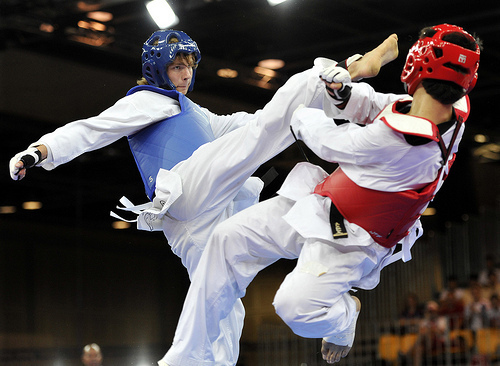
Taekwondo match. Photo: Singapore Youth Olympic Games / Flickr
Have you ever wanted to study martial arts? One of the great things about travel is that you don’t have to settle for a “McDojo” in your local shopping mall. You can take a journey to the best place in the world to study your fighting style. There was an article in CNNGO titled, Asia’s martial arts capital is . . . Singapore?
When I lived in Taiwan, I met a group of guys who all studied with the same baguazhang master, Luo Dexiu. The students told me that for Chinese martial arts, it was actually better to go to Taiwan and Hong Kong, rather than China. In some cases, masters would settle in the United States and Europe because those were the bigger markets. I would be curious to hear from our readers if this migration has happened with other martial arts experts?
One thing I noticed is that you often don’t study with the master himself. A senior student will lead the lessons. Meanwhile, the master will walk around the students as they perform drills; he’ll make inspections and corrections.
When I worked in China, I rarely met Chinese practitioners of martial arts. Most students were foreigners who had traveled in to study. This might be because I lived in Shanghai. Big-city types tend not to study kung fu as much as people in the countryside, a longtime expat explained. I did meet one Chinese guy who studied xingyiquan because his father was a master. I asked him what fighting style was fast to learn and effective in real street fights. His prompt answer: “American boxing!” Although he said that in sparring matches against fighters with different styles, he thought that Thai kickboxers were the toughest to beat.
One of my British friends was a serious student of praying mantis kung fu. He had a similar comment, saying that in his sparring matches, Thai kickboxers were the best-conditioned. On a different tack, he played down the choice of style and stressed the importance of regular training. He said something like he’d bet on a serious boxer over a lazy kung fu student any day.
Have you studied martial arts? In which countries and schools did you train in? Please share your experiences in the comments.
Original article can be found here: Best place in Asia to study martial arts?
September 7, 2012
Special September 2012 fares for multi-stop tickets on BootsnAll
Vagablogging :: Rolf Potts Vagabonding Blog
Why do you travel?
In a recent BootsnAll article, author Jo Fitzsimons reflected on her time at the famous Full Moon Party on Koh Phangan during an extended trip. After a conversation with a fellow traveler, she began to question why it is that we travel?
While I’m never going to be one to say travelers shouldn’t party or go to famous tropical islands for a few days of debauchery, I also know that there should be a balance. Letting loose, having fun, and maybe being a little stupid every once in a while is not a bad thing – both in everyday life and while we’re on the road.
But when partying and hanging out with only other travelers is all one does on the road, it might be time to re-assess why it is you left in the first place. Jo outlines some great ideas and tips for remembering why we travel.
If you are ready to hit the road for a big trip, then check out BootsnAll’s monthly airfare deals. The following are good through September 30, 2012:
Circle the Pacific Los Angeles – Nadi (Fiji) – Auckland – Sydney – Beijing – Los Angeles from $2619.
Four Corners Africa New York – Dakar – Johannesburg – Nairobi – Cairo – New York from $3110.
Asia Hopper with Russia New York – Moscow – Delhi – OVERLAND – Bombay / Mumbai – Colombo – Bangkok – Shanghai – OVERLAND – Beijing – New York from $2517.
Dictator Route Seattle – Frankfurt – Moscow – Beijing – Seattle from $1713.
Around the World in 80 Days London – Cairo – Mumbai – Calcutta – Hong Kong – Tokyo – San Francisco – New York – London from $2722.
If you are looking for something a little different in your round the world trip, then start planning your trip of a lifetime with our RTW trip planner And don’t forget to sign up for BootsnAll’s RTW newsletter, delivering special deals, RTW trip planning advice, and resources via email every single month. We also have a Facebook fan page and Twitter page, so be sure to like and follow those to keep up to date on all your RTW travel needs.
Original article can be found here: Special September 2012 fares for multi-stop tickets on BootsnAll
September 6, 2012
A guide to Central Asia: Caravanistan
Vagablogging :: Rolf Potts Vagabonding Blog

I would like to introduce a very good online resource dedicated to Central Asia, one of those regions where traveling still comes with a fair amount of headaches. Caravanistan is a complete regional guide divided by country that I used a lot to check for actual information in the labyrinth which Central Asian bureaucracy can be.
I decided to contact the author, Steven Hermans, and ask him a few questions regarding his project. He decided to start Caravanistan doing an overland trip from Europe to China in 2010.
“I had done all my research through the usual channels (Lonely Planet forum, Wikitravel etc.) and I thought I knew what I was doing. However, when I arrived to Kazakhstan and applied for a Chinese visa, they told me it was not possible for foreigners, even though previous reports said it was no problem. As I was stubborn and did not want to fly, and there was a revolution in Kyrgyzstan at the time, I had no choice but to return to Europe by Russia. Things keep changing all the time in Central Asia and I noticed a lot of people get stuck in similar ways, having to change their travel plans because of bad information”
Steven has kept an interest in Central Asia after he married a local girl he met during that same trip in Kazakhstan, and moved into the region. But what is so good about Central Asia for an independent traveler? “Outside of a few tourist hotspots” he says,” you’re always the only foreigner around. For those independent travelers trying to get away from the tourist circus of Asia or South America and get into the life of people, it’s a great region. People are very open and hospitable, and it’s very easy to make friends with almost anyone and experience a totally different culture and view of life”. After my recent visit to Central Asia, I can agree with Steven. “Samarkand, Bukhara and Khiva are the only places in attracting mass tourism, and they may surprise the overlanders who are used to being left alone in other parts of the region. But this is inevitable, I feel, as they are major world historical sites. So we need to accept that, or go outside of the tourist hours. See the Registan moonlit at 3am, or visit Khiva snow-covered in winter, and I promise you, you will be all alone!!” he continues.
Caravanistan is building up steadily and already provides a wealth of good information to help plan serious travel to Central Asia, and there is much more in the pipeline. “My main aim” says Steven ”remains to keep the practical information up to date: visas, transport, border crossings… There has to be a trusted source, as I am expecting a lot of instability to hit the region over the next few year. Furthermore, no other established travel brand has managed to fill that gap: for this reason, I also would like to slowly build a complete travel guide to all the destinations in Central Asia, one that is much more detailed than those currently on offer from Bradt, Lonely Planet or Wikitravel. With the online version of Caravanistan I want to introduce the region’s culture, both old and new, but also discuss the current issue. Central Asia is not Thailand – you cannot travel here without having an interest in human rights, politics or ecology. I want to discuss these things with my readers, for me these topics are not separate from travel. And ultimately, I want to make a connection between crafts people and tourists, and promote ecotourism, as the infrastructure is there, but people are just not showing up, nobody knows about it. I hope my website can function as a gateway for them in the future”.
Planning a trip to Central Asia? Look no further, log onto Caravanistan and start getting the latest, most useful information!!
Original article can be found here: A guide to Central Asia: Caravanistan
September 5, 2012
Long-distance footpaths
Vagablogging :: Rolf Potts Vagabonding Blog
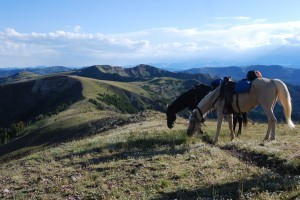
My two horses stop for a snack along the Continental Divide Trail in Montana/ photo/ Lindsey Rue
Recently I’ve been reading, “Wild” by Cheryl Strayed. When the author was in her mid-twenties she solo hiked the Pacific Crest Trail. Her book unfolds as she treks north, nursing her blistered feet and cumbersome heavy pack along a majority of the 2,663mi (4,286km) trail. It initially begins at the Mexican border, passes through California, Oregon, and Washington in the USA and over the border into Canada. Several years ago I’d been gearing up to ride my horses along the same trail, but heavy snows in high mountain ranges and challenges with support team coordination threw a wrench in the trip–so it never happen. But I did ride sections of that trail, along with parts of the Continental Divide Trail, Chilkoot Trail, and the historic Oregon Trail. On foot I’ve graced sections of several other long paths, and driven a dog cart on one pulled by twelve huskies.
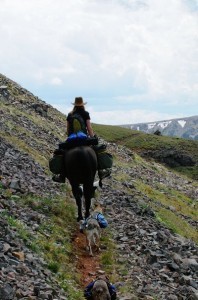
Riding the Divide/ photo/ Ryan Talbot
Reading Strayed’s book got me thinking about other long-distance footpaths around the world. A popular one in Europe that comes to mind is El Camino de Santiago which starts many different places but ultimately ends at Santiago de Compostela in Spain. I first heard of the trail in a novel by Paulo Coelho called, “The Pilgrimage.” Other countries in Europe such as Germany, Italy and the Netherlands have quite a lot of paths. In Asia I’d looked into hiking the Annapurna Circuit in central Nepal. But it appears that Israel and Japan have many for the choosing as well; Japan’s most popular being the 88 Temple Pilgrimage.
Here are the worlds’ best hikes according to National Geographic.
Mark Moxon has an extensive website of information and stories from his long walking adventures.
The UK has a Long Walkers Association.
One Canadian man even walked around the world in eleven years.
Have you ever hiked or ridden on a long-distance path? Or do you have plans to do so?
Please share your stories or plans in the comments!
Original article can be found here: Long-distance footpaths
September 3, 2012
What kids learn from travel
Vagablogging :: Rolf Potts Vagabonding Blog
I often talk about how much my sons have learned from our travels, but it’s hard to actually explain what they’ve learned.
Yes, they learned all the “school stuff” – reading, writing, math, science, social studies. But more importantly, they learned valuable life lessons that will get them through life.
They learned that life isn’t necessarily a bowl of cherries. There are some days that are rainy…
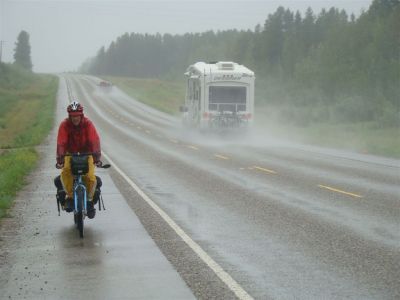
…or cold…
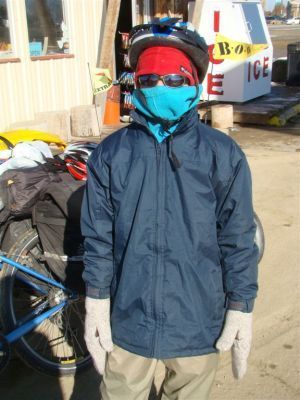
…or windy.

There are times when we have to grind our way up hills that seem like they’ll never end.
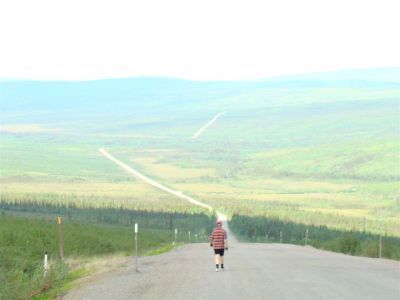
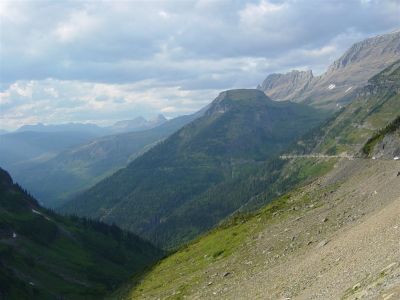
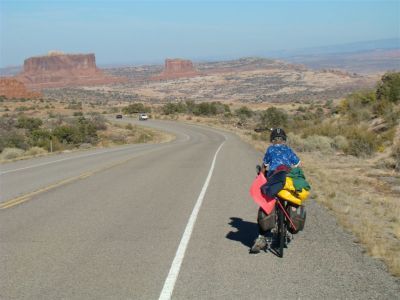
But they’re also learning the thrill of victory. They’re learning they can reach the top of those proverbial hills…
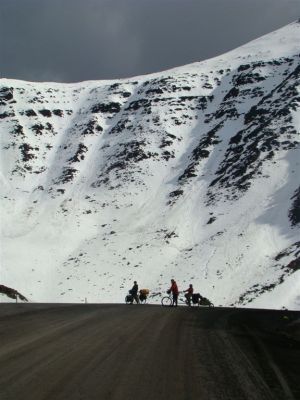
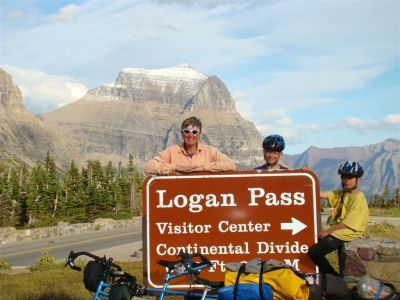

They can cross countries one pedal stroke at a time.
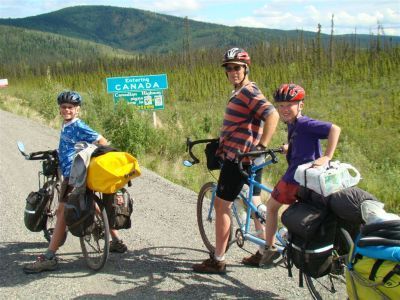

And they’ve learned that people are good. Humankind is basically kind and generous and giving and welcoming – not like one would believe from watching the nightly news.



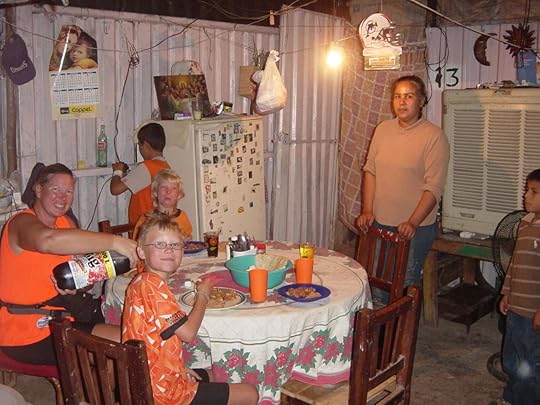
That’s all stuff that can’t be learned in a classroom.
I think my husband said it best: The world is our classroom and our travels are our textbook.
Original article can be found here: What kids learn from travel
September 2, 2012
Paul Theroux’s “Essential Tao of Travel”
Vagablogging :: Rolf Potts Vagabonding Blog
1. Leave home
2. Go alone
3. Travel light
4. Bring a map
5. Go by land
6. Walk across a national frontier
7. Keep a journal
8. Read a novel that has no relation to the place you’re in
9. If you must bring a cell phone, avoid using it
10. Make a friend
–Paul Theroux, The Tao of Travel (2011)
(2011)
Original article can be found here: Paul Theroux’s “Essential Tao of Travel”
September 1, 2012
Vagblogging Field Reports: scuba diving in the Bay Islands and Cayos Cochinos, Honduras
Vagablogging :: Rolf Potts Vagabonding Blog
Cost: $50-60 a day
What’s the strangest thing you’ve seen recently?
Immediately after learning to scuba dive in Utila, I hopped on over to nearby Cayos Cochinos (Hog Islands). Some of the small islands and cayes that make up Cayos Cochinos resemble one of those ‘paradise island’ posters that bored office workers paste on their cubicle walls to remind them of the next holiday they’re working towards. You know the ones. Chalk white sand at their perimeters and a couple of lonely coconut trees with an obligatory hammock slung across them. The waters are clear turquoise and the shallows hint at the abundant marine life that abounds in the deeper waters. Bait fish flit around as spotted eagle rays glide past. At night queer bio luminescent creatures twinkle in the inky waters creating a bizarre light show.
Under water things are perhaps stranger. Shortly into our fifth dive along a big reef wall at a dive site called Pelican 2 my girlfriend and I were met by a small remora fish that ended up accompanying us for the entire dive. Remora’s attach themselves to sharks or large fish via a sucker on top of their heads so they may get a free ride and feed on the scraps of food produced by their larger hosts feeding habits. This particular remora was somewhat confused and continuously tried to attach itself to my girlfriends upper thigh. Given that she is highly unlikely to start devouring reef fish mid-dive the little creature was out of luck.

Diving off Utila
At one point in the dive we saw a majestic hawksbill turtle flapping elegantly along the reef wall. We followed it for a short while before it moved off into deeper water. At this point our remora companion saw the turtle and decided to check out the heavy shelled reptile. It quickly swam towards the departing turtle with an awkward wriggling motion, sussed the situation out and upon deciding the herbivore wasn’t worth its time turned back and returned to us.
Towards the end of the dive the remora rejected my girlfriend and decided to attempt attachment on me. It tickled but after a while I gave up fending him off and let him nibble at bits of debris attached to my wet suit. I felt a little warm inside at making a new friend and was a touch sad when our dive ended and we had to part ways.
Describe a typical day
Life for tourists and many of the locals in the Bay Islands and Cayos Cochinos revolves around diving. Waters are generally calmer in the mornings so we rise early and chow down some cornflakes (apparently one of the only cereals sold on the island) and a couple of slices of toast. Gear is organized in a methodical manner so that no essential item (mask and snorkel, for instance) is forgotten. The crew sets out and the boat captain, who’s invariably a jovial Garifuna gent grins, cracks jokes and talks loudly in a thick Caribbean accent. It feels good being out on the water this early in the day and I’m always eager to get in the water so that my eyes may be delighted by some creature or coral formation I’ve not encountered before.
We anchor, go through our safety checks and descend. Diving isn’t an entirely silent experience but the array of sounds heard above land are absent. Mostly I hear myself breathing through my regulator like Darth Vader. The sound deprivation serves to enhance the visual treat. I never know what I’m going to see underwater and this, of course is what makes diving so addictive. On any given day I may see an inquisitive morray eel following me, a giant tarpin zoom off after I round a corner in the reef, or hundreds or garden eels poking their stringy bodies out of the water only to duck back under the sand as I come near.
After a couple of dives we’re always ravenous so when we return to shore the gear is cleaned and hung up to dry for the next day before we hurry on to our favorite lunch spots. I usually go for an inexpensive restaurant serving baleadas. Found only in Honduras, baleadas are essentially flour tortillas wrapped around refried bean paste, eggs and cheese. They rarely blow you away but they fill you up for a few lempiras. It’s usually baking hot during lunch and a fruit drink with milk and crushed ice, known as a licuado is an essential part of the dining experience.
Afternoons and nights are lazy and tend to revolve around hammock time, studying dive material or sipping on ruminades (rum + home made lemonade).

Cayos Cochinos sunset
Describe an interesting conversation you’ve had with a local
I met Jim the night watchmen at Deep Blue Divers, the dive shop I did my certification through. Jim’s an elderly white islander with sad blue grey sailors eyes, a heavily wrinkled face like a crumpled up piece of paper and a strong Caribbean accent. I imagine he has stories of dangerous tentacled sea beasts and treacherous seas, however I wouldn’t know because despite him speaking English I barely understood him. The islander accent here is the only English accent I’ve encountered thus far that I’m completely baffled by. He often ended sentences with “Aaaaaright”.
I did gather he has a daughter who’s married to an American man. She’s had an awfully hard time getting into the USA due to their stringent immigration policies. Oddly, despite his daughters troubles, Jim said that he thinks the USA needs to be hard on immigration to protect their interests and prevent it from being overrun by foreigners………at least I think that’s what he said.
What do you like about where you are? Dislike?
I like the peaceful feeling diving gives me and the diversity of marine life present in and around the reefs. Every dive is different, even at the same dive site as conditions change and different marine animals come and go.
The food and drink on some of the Islands, particularly Utila is delicious. My diet for the most part consists super baleadas (thats right, super) with avocado, fresh fish and licuados.
The Garifuna islanders, descendants of African slaves, are a warm, attractive people that inhabit pockets of the islands and northern coast of Honduras. I met a few Garifuna on Chachuate One in Cayos Cochinos and enjoyed getting an insight into their way of life. They sleep outside in hammocks (unless there is a tropical storm), eat freshly caught fish and drink plenty of rum. There are a couple of rusty generators on the island but for the most part their way of life is devoid of electronics. It’s a simple life in an incredibly picturesque past of the world, but I couldn’t help but think I’d eventually get bored.

Garifuna paddling at Cayos Cochinos
It’s an accepted fact that foreigners pay more for stuff than locals when traveling in developing nations and I’m okay with that. That being said it does get tiresome when taxi drivers are trying to get you to pay them ten times the going rate. When you step off the ferry at Roatan you’re greeted by numerous drivers offering you a ‘great deal’. Ten US dollars for a ten minute cab ride to West End. When you suggest that you can get a collectivo taxi for $1.50 they act incredulous and suggest that maybe ten years ago that was the case (ten years ago all of the taxi drivers were on the mainland). Unfortunately I’ve continuously encountered locals trying to fleece me for what are astronomical sums over here.
Describe a challenge you faced.
Central America is not quite as inexpensive as I thought it would be prior to my travels. The Bay Islands, despite offering some of the cheapest diving in the world, are a step up in terms of expense from most of mainland Central America. I’ve come to realize that diving is an expensive hobby even in the cheapest of places. Many a baleada has been consumed as I’ve tried to save money.
In terms of scuba diving maintaining buoyancy has been the greatest challenge. I had visions of me gliding through the water like a bottlenose dolphin, but at least initially, I was flailing my arms around in a particularly ungraceful manner in order to stay at an appropriate depth. But like with any new pursuit maintaining my buoyancy became a lot easier with time and practice.
What new lesson did you learn?
The practicalities of scuba diving have enabled me to enter into a part of the world I never could’ve otherwise. The experience of being underwater has re-enforced a lesson I learnt long ago watching Attenborough documentaries. About 71 percent of the worlds surface is covered by water. Humans are perhaps the most adaptable species in the entire planet and certainly the most advanced, yet we ‘re only visitors to the underwater world and only to a small portion of this world and only for a short while. When you consider that we’re only capable of inhabiting a tiny portion of our planet, which is a tiny speck floating in an incalculably huge cosmos it’s impossible to not feel humbled.
Where to next?
On to mainland Honduras and Nicaragua.
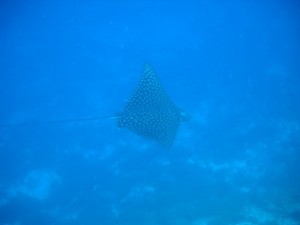
Spotted eagle ray
Original article can be found here: Vagblogging Field Reports: scuba diving in the Bay Islands and Cayos Cochinos, Honduras
August 30, 2012
The limits of digital vagabonding
Vagablogging :: Rolf Potts Vagabonding Blog

In the past year I met a few travelers that liked to call themselves “digital nomads”: people who can travel the globe and work remotely from an internet connection, everywhere in the world. However, as I was enjoying some remote mountains and almost missed my weekly deadline, I have a couple things to say about this whole concept of “digital nomadism”. It may work, for sure, as we have seen many successful examples and life stories all over the world. But believe me, it does not work anywhere. It does not work for sure in the mountains of Tajikistan, I guarantee, where it is also difficult for example to find a daily shower or a flush toilet. And it becomes a very excruciating exercise when the speed of the internet connection you are using resembles those dial-up modems I remember using around 1995. It just becomes worst than 8 full hours at the office when outside the sun shines summertime.
When I try to remember such self-proclaimed digital nomads that the world can be slightly wilder than the average location in Thailand or South America, I am generally given a strange look. Kind of like I doubted the universal power of the internet, or I just unknowingly touched a very taboo topic.
Personally, I believe that traveling the world has to be disconnected from the internet. I mean, if we are lucky enough to make some sort of living by leading a nomadic lifestyle, we do not have to limit our movements only to those locations where a good connection is available. Instead, it looks like the internet connectivity may monopolize our movements and make us digital slaves, not nomads. I have seen so many remote places charging deadly high amounts for painstakingly slow connections… so slow it almost hurts to use them. And still, I can see travelers trying to type away at a monitor that never loads, and neither refreshes.
To be able to work and still enjoy traveling to off the beaten path locations the way I want, I generally prepare my writing some weeks before. I schedule the posts thanks to modern technology, and forget about them for a while. However, life is unpredictable and sometimes I am not able to write as much as I would when I have to organize my movements across the badlands of the world. And it is in those cases that I realize that limiting ourselves to the safety net of a fast internet connection is a big mistake. It feels like putting a condom around the travel libido, stopping the opportunities to make great encounters, and just feels plain antiseptic.
Nevertheless, people typing away at fast speed internet points in Buenos Aires or Berlin still like to think they have a different perception of the world, and enjoy some sort of traveling freedom. I certainly do not want to criticize any lifestyle choice, but I feel much luckier when there is scarce electricity, I cannot charge my smartphone, my laptop has a dead battery, and the internet is some sort of invention that still has to reach the part of the world where I am luckily spending my day. Free from the worries of the digital world. Free to make my travel experience the same vibrant moment of incredible enthusiasm that got me out of my hometown first a bunch of years ago.
That feeling still seems to resist when I disconnect from the internet world, and pay more attention to the hidden corners of the real one. What is your opinion?
Original article can be found here: The limits of digital vagabonding
Rolf Potts's Blog
- Rolf Potts's profile
- 323 followers



